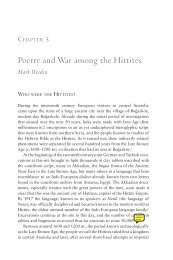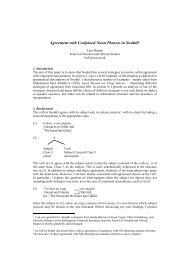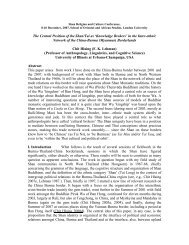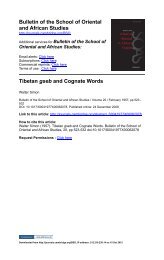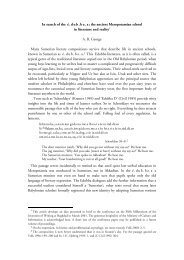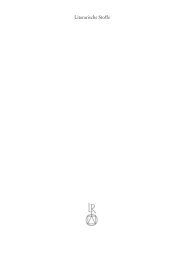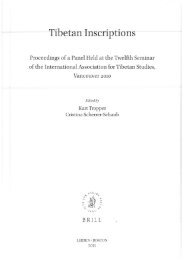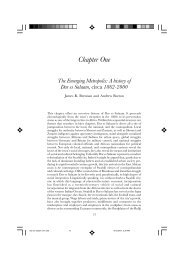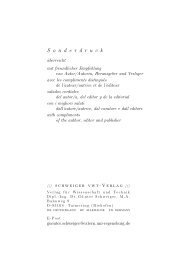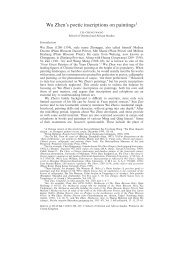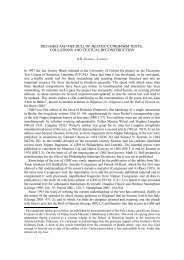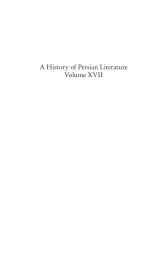000_JLC3_debut_FL - SOAS Research Online
000_JLC3_debut_FL - SOAS Research Online
000_JLC3_debut_FL - SOAS Research Online
You also want an ePaper? Increase the reach of your titles
YUMPU automatically turns print PDFs into web optimized ePapers that Google loves.
4 Friederike Lüpke<br />
1. There are very few, if any, studies that describe not the contact between an<br />
official/European languages with a well established and enforced discrete identity<br />
and one or several African languages (e.g. Creole studies, Myers-Scotton 1993;<br />
Swigart 1994; McLaughlin 2001, 2008, etc.), but contact between and<br />
multilingualism in African languages. The reasons for this limitation lie in the<br />
unsatisfactory amount of sociolinguistic, descriptive and documentary knowledge<br />
for all but the largest African languages—it is simply not possible in most contact<br />
situations to identify lexical and structural interferences because no linguistic<br />
information on one or several of the contact languages is available. The discussion<br />
of the word for ‘panther’ in Joola Bandial and its contact language Baïnounk<br />
Gubaher (Cobbinah, this volume pace Sagna (2008)) illustrates how a languageinternal<br />
analysis can become less plausible as soon as linguistic information on the<br />
contact language(s) is taken into account, while at the same time confirming the<br />
urgency of more basic descriptive and documentary research on West African<br />
languages.<br />
2. The traditional setup for the ‘ordinary fieldworking linguist’ can be roughly<br />
summarised as ‘one person, one language’—the classic ‘lone wolf’ scenario. This<br />
setup entails very limited manpower and a narrow disciplinary perspective, so that<br />
variation in descriptive grammars and dictionaries appears in general greatly<br />
reduced. A seemingly homogenous snapshot of a ‘language’ is taken, in past<br />
studies often even without mentioning where and with whom the data used were<br />
collected. Therefore, the existing linguistic material is incompatible with detailed<br />
sociolinguistic studies of variation—which, as demonstrated for instance by the<br />
study on social networks as a factor of language change conducted by Beyer (this<br />
volume), requires amounts of quantitative data way beyond the possibilities of<br />
basic descriptive and documentary efforts.<br />
3. The perspectives of sociolinguists, anthropologists and descriptive and<br />
documentary linguists on notions like ‘language’, ‘dialect’, ‘mother tongue’,<br />
‘speech community’, ‘ethnicity’, ‘identity’ and other contentious concepts have<br />
been, until recently, very incompatible in terms of acknowledging and<br />
parameterising variation and inventorying and comparing multilingual settings.<br />
Linguists are quite attached to models that make use of discrete notions like<br />
‘language’ and associated concepts, although they may be hard to corroborate in<br />
practice and require a good understanding of extralinguistic factors and patterns<br />
and hierarchies of multilingualism. Linguists tend to take an axiomatic approach<br />
to many of these notions, since for them, the structural properties of a code<br />
(unconsciously or consciously idealised and homogenised) are their core concerns.<br />
Sociolinguists and anthropologists, in contrast, are notorious for deconstructing<br />
such terms to the extent that few, if any, generalisations can be made beyond the<br />
profile of an individual. Lüpke (this volume) addresses the contentious issue of<br />
identifying codes and retraces the laborious first steps of identifying speech<br />
communities, their language(s) and the relevance of linguistic repertoires for their<br />
identity.<br />
5. The contributions of this issue to West African contact linguistics<br />
The papers in this special issue constitute a first step in redressing this situation: they<br />
present the state of the art in approaches, analyses, and outlooks on the multifaceted topic<br />
they investigate, and make specific recommendations for avenues of research to pursue.<br />
The first two articles chart the territory for the entire special issue by making the central<br />
but often neglected point that language contact is always a result of multilingual speakers<br />
being in contact with each other, and that to look at only the linguistic or only the social side<br />
of the process will never reveal the full picture. Tucker Child’s contribution, a large-scale<br />
Journal of language contact – THEMA 3 (2010)<br />
www. jlc-journal.org



